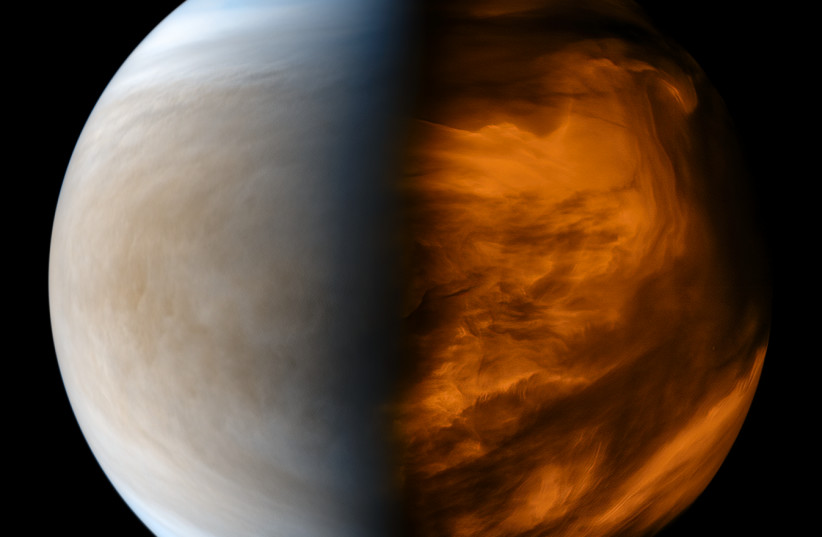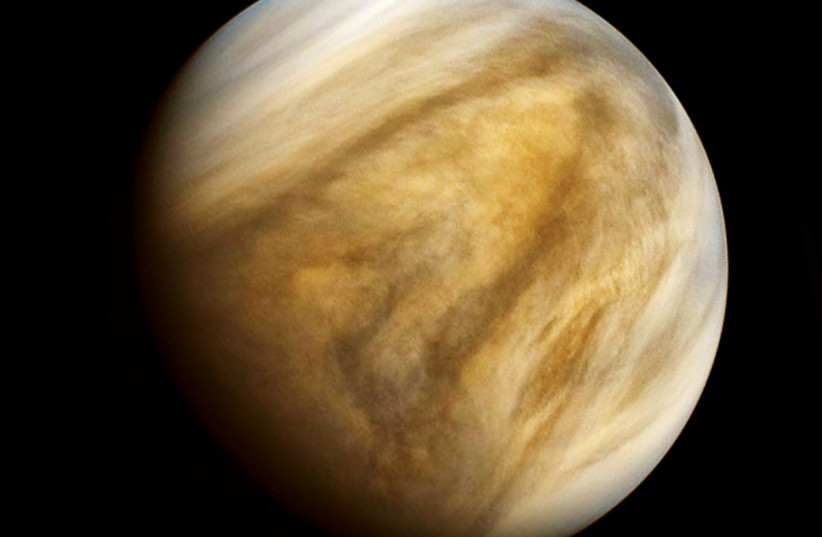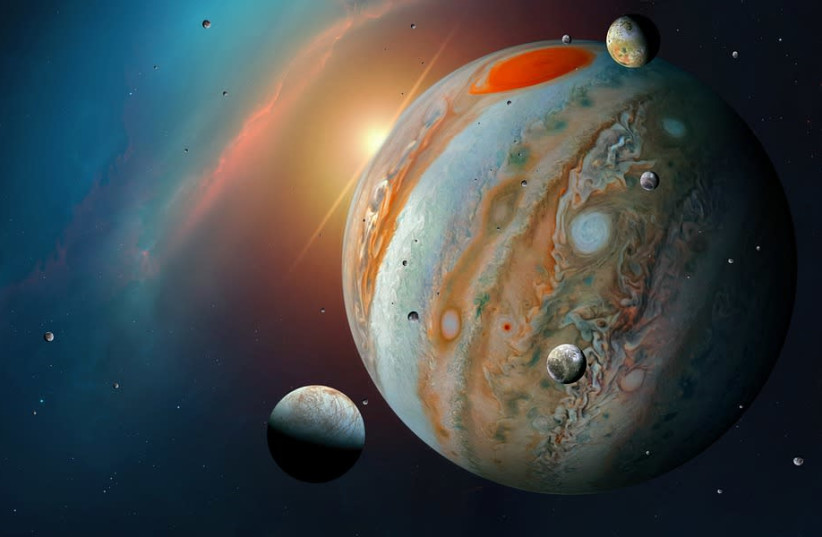The search for life across the stars is one of the most intriguing fields in science, but while some look to the far reaches of the cosmos, a new privately funded scientific mission is turning its attention to one of our closest neighbors in the solar system: Venus.
Dubbed the Venus Life Finder Missions, the series of projects is being carried out by a team of Massachusetts Institute of Technology researchers, led by Jewish-American scientist Sara Seager. Their first mission, currently slated to launch in 2023 on a rocket provided by California-based Rocket Lab, will send a probe on a five-month journey for a three-minute trip to Venus’s clouds.
But the probe will come equipped with a specially designed laser instrument to detect complex chemistry inside the clouds. If any impurities or fluorescence are found, it could indicate that there’s more to the Venusian atmosphere than meets the eye.
VENUS IS one of Earth’s closest neighbors. It’s so similar in size that NASA has noted its nickname as “Earth’s twin.” However, its climate and atmosphere are radically different from ours. For one thing, the planet has a far slower rotation. The jet stream blows west to east – the opposite of Earth’s – and its winds blow incredibly fast.
And then there’s the temperature, which is hot enough to melt even lead.

“The temperature on the surface of Venus is about 460°C, on average, so all water is in the form of vapor,” explained Itay Halevy, an associate professor of Earth and planetary sciences at the Weizmann Institute of Science, who is not involved in the mission.
The inhospitable nature of the planet has long been a challenge for scientists.
Space agencies have sent probes to the planet before. It was first scanned by a NASA probe in 1962, and later explored by others. Some of these continued recently, such as NASA’s Parker Solar Probe.
Landing missions, however, are another story, and are far more difficult than the many probes and rovers sent to explore Earth’s other closest neighbor, Mars.
In the past, both the US and USSR attempted to land probes on Venus. However, the adverse conditions always ensured they never lasted long, unable to stay functional in the intense pressure and heat. Back in 1978, NASA managed to land a probe onto the planet itself. It lasted only an hour.
The reason for Venus’s extremely high temperature is the thick atmospheric greenhouse effect. Venus’s atmosphere is composed almost entirely of carbon dioxide, a compound that traps heat, and its surface pressure is about 90 times higher than Earth’s.
It is this intense greenhouse effect that keeps the surface temperature so high that water is always in its gaseous state.
But this has an added effect on the atmosphere.
“Imagine you’re on an airplane,” Seager explained. “The higher you go, the thinner the air and the lower the temperature. Venus is like that, too. And these clouds that form [in this part of the atmosphere] are similar in temperature to Earth’s surface.”
So these clouds would therefore be the most hospitable places on Venus, the most likely part of the planet capable of supporting life.
But temperature is only one aspect that makes Venus so utterly inhospitable, as we understand it.
“As far as our current understanding of Venus’s atmosphere goes, no life as we know it could survive there,” Seager admitted.

The reason for this is the composition of Venus’s clouds. At first glance, the clouds, which contain wate, could be seen as a possible home for life, since water and sunlight would allow plant life to conduct photosynthesis. However, there is another compound in these clouds that presents a much bigger challenge: sulfuric acid, an extremely corrosive and deadly substance that cannot exist in its pure form in nature on Earth. It is commonly used in products like antifreeze and to remove rust from metal.
The concentration of sulfuric acid in the clouds of Venus far exceeds anything remotely possible on Earth and would kill all life on Earth, even the hardiest of extremophiles – life forms like tardigrades, which can survive in otherwise nearly inhospitable conditions.
BUT DOES that mean that it is entirely impossible that these clouds can host life?
In theory, no.
According to Seager, it is theoretically possible that these clouds could host certain types of bacteria that don’t require aerobic respiration, meaning they don’t need oxygen to breathe. These hypothetical anaerobic bacteria could possibly live in these clouds and produce ammonia, which could, in sufficient quantities, neutralize the acid to the point where it becomes possible to survive.
But this raises more questions, such as how life ended up in the clouds in the first place, and why do some scientists think it could be there at all?
To answer the first question, Seager points to the overall similarities between Venus and Earth.
“Venus once could have been a lot like Earth, with oceans and a normal climate,” she explained. “However, the greenhouse effect could have changed this, evaporating oceans and making the surface inhospitable. Bacteria could have essentially been blown up into the atmosphere, the last remaining remotely hospitable place left.”
There is some precedence to this, too.
“There are microbes in Earth’s atmosphere, mostly in a sort of suspended animation. These originated from the surface and were blown into the atmosphere in droplets or dust particles,” Halevy said.
“Under the right conditions, with water and a source of energy, they become active again. However, it’s hard to say what would happen if all of Earth’s surface environments became inhospitable, and airborne microorganisms were all that was left.”
This idea that the airborne bacteria would be in the clouds is what Seager is suggesting. However, as clouds are not very dense, it is possible that these life forms would, essentially, fall down toward the surface, where they wouldn’t be able to survive. But while there, they could enter the state of suspended animation known as cryptobiosis until they are brought back up through high winds.
“On Venus, the atmosphere is very stable below the clouds, so any liquid evaporates and the droplets become lighter,” Seager explained. “What I’m imagining is that in this sort of layer, there are sleeping spores, waiting to be brought back up.”
SO WHY do we think life might be on Venus at all?
There are two reasons.
First, there is evidence of something in Venus’s atmosphere that absorbs ultraviolet (UV) waves from the Sun.
Some believe this unidentified UV absorber could be a pigment similar to chlorophyll, the pigment plants use for photosynthesis. However, there isn’t much evidence yet supporting this theory.
The other reason was discovered by Seager herself.
In a study published in September 2020 in the peer-reviewed journal Astrobiology, Seager and her team detected a signal indicating the presence of phosphine in Venus’s clouds. Variations of this gas can be found on Earth. However, phosphine is typically produced by life forms.
But can phosphine be formed in other ways?
Technically, yes.

Phosphine exists in the atmospheres of Jupiter and Saturn – and likely in other gas giants (planets composed of gases such as helium and hydrogen that lack a rocky surface). There, it is made at high temperatures and pressures in deep atmospheric layers. This is something Seager and her team explained in the 2020 study.
But Venus is no gas giant. Like Earth, it’s rocky, and that rocky surface walling off the interior of the planet would pose an obstacle. Furthermore, the oxidized crusts and atmospheres would essentially destroy the naturally produced phosphine.
Therefore, if there is phosphine on Venus, there must be life, right?
Not necessarily. After all, it is possible that phosphine forms in some other way that scientists don’t yet understand. What is more, the 2020 study came under criticism. Some took issue with the data analysis and found that errors had been made in the original study.
Later studies were able to re-detect the initial signal, though at slightly lower significance, but others debated whether the signal actually indicated that the compound wasn’t phosphine but sulfur dioxide. However, the team members behind the study point out that the evidence doesn’t support sulfur dioxide being the source of the signal.
Further, it isn’t just their own analysis that led them to this conclusion. The team had also found evidence of phosphine in Venus’s atmosphere by looking over old archived data from the NASA Pioneer Venus Neutral Gas Mass Spectrometer, from NASA’s Pioneer Venus mission in the late 1970s.
But while they still stand by their findings, they admit that it is still possible that the signal could be another unknown gas.
IN SHORT, there is so much still unknown about Venus and its atmosphere, and that’s why this mission is so important.
It is arguably more likely that life exists on Venus than on gas giants. While these massive planets have clouds that could, in theory, have similar conditions to Venus that would allow for anaerobic bacteria to live, there are other complicated factors at play.
“Gas giant atmospheres are composed predominantly of hydrogen and helium. However, there are, relatively, low concentrations of other gases like methane, ammonia, sulfur dioxide and water vapor,” Halevy explained.
“These condensable gases form clouds high in the gas giant atmosphere, where temperatures are low enough. For example, what we see when turning a telescope to Jupiter are its uppermost clouds, which are thought to be composed of ammonia and sulfur compounds.
“Life based in such clouds would be even more different than the life proposed to exist on Venus, which presumably lives in short-lived aqueous environments that are highly acidic. Life in ammonia-sulfur clouds would be even more radically different.”
Furthermore, there is another issue: falling.
Life in gas giant clouds could, like on Venus, fall down. But unlike Venus, there is no rocky surface at the bottom.
“One of the many problems of life in clouds is that it can fall through where it gets hotter. On Jupiter, all the turbulence in the atmosphere would take it down where it gets hot,” Seager explained.
The turbulence in Jupiter’s atmosphere is well documented, with astronomers noting the presence of many storms, likeas the famous Great Red Spot.
These storms are also incredibly deep – far deeper than anything on Earth. According to a study by NASA and Weizmann’s Prof. Yohai Kaspi and Dr. Eli Galanti, the Great Red Spot is 500 kilometers deep. For comparison, if a storm this big manifested on Earth, it would reach the International Space Station.
But there is another aspect about Venus that is especially interesting and that makes this study so important: its feasibility.
Scientists have long looked for life on other worlds, and have taken to studying distant exoplanets. One way many have gone about doing this is through detecting compounds and pollutants that could only have a biological origin.
“By studying the light when a planet is in front of its star, you can detect the atmosphere’s impact on the light, meaning you can determine the chemicals in the atmosphere,” explained Prof. Avi Loeb, an Israeli-American physicist at Harvard University and science theory director for the Breakthrough Initiatives, who is one of the leading mainstream scientific voices advocating for the possible existence of alien life.
“That includes molecules that are produced like carbon dioxide and water vapor, and ones like oxygen or methane. That could be indicative of primitive life, though on Earth for the first two billion years there wasn’t much of an atmosphere. For the first half of Earth’s history there were microbes but no oxygen, so a lack of oxygen is not necessarily indicative of no life, and oxygen could also be naturally produced.”
In his work, Loeb suggested looking to detect larger, more complex molecules. “These cannot be naturally produced, and are always artificial, usually the result of refrigerators and industry,” he said.
Loeb also heads the Galileo Project, a scientific initiative to use unified telescope networks to find evidence of alien life through the presence of, essentially, garbag. It is through this methodology that he advocates looking for life on other words.
But Venus is another story because it is so close to Earth. As a result, sending a probe is something actually feasible.
“This is a visionary mission that will inform us whether there is life in the clouds of Venus,” Loeb said regarding the Venus Life Finder Missions. “The only way to find out for sure is by physically visiting the planet’s atmosphere. It would be most exciting if the mission would discover ‘life as we do not know it.’ One way or another, we will get new constraints about the environments that support life beyond Earth.”
Though it hasn’t been launched yet, further missions are already in the works. A follow-up mission is already being declared for 2026. This time, a larger probe will be sent that could stay in the clouds for longer periods of time and gather more data. And all of that will lead up to the ultimate culmination of the entire project: bringing back a sample of the Venus atmosphere.
And this effort is important because even if no life is found on Venus, there is one thing for sure: there are still mysteries that need to be solved, anomalies that are not understood. This mission, regardless of whether it finds evidence of life, will bring us one step closer to understanding the mysteries of the universe and our place in it.
